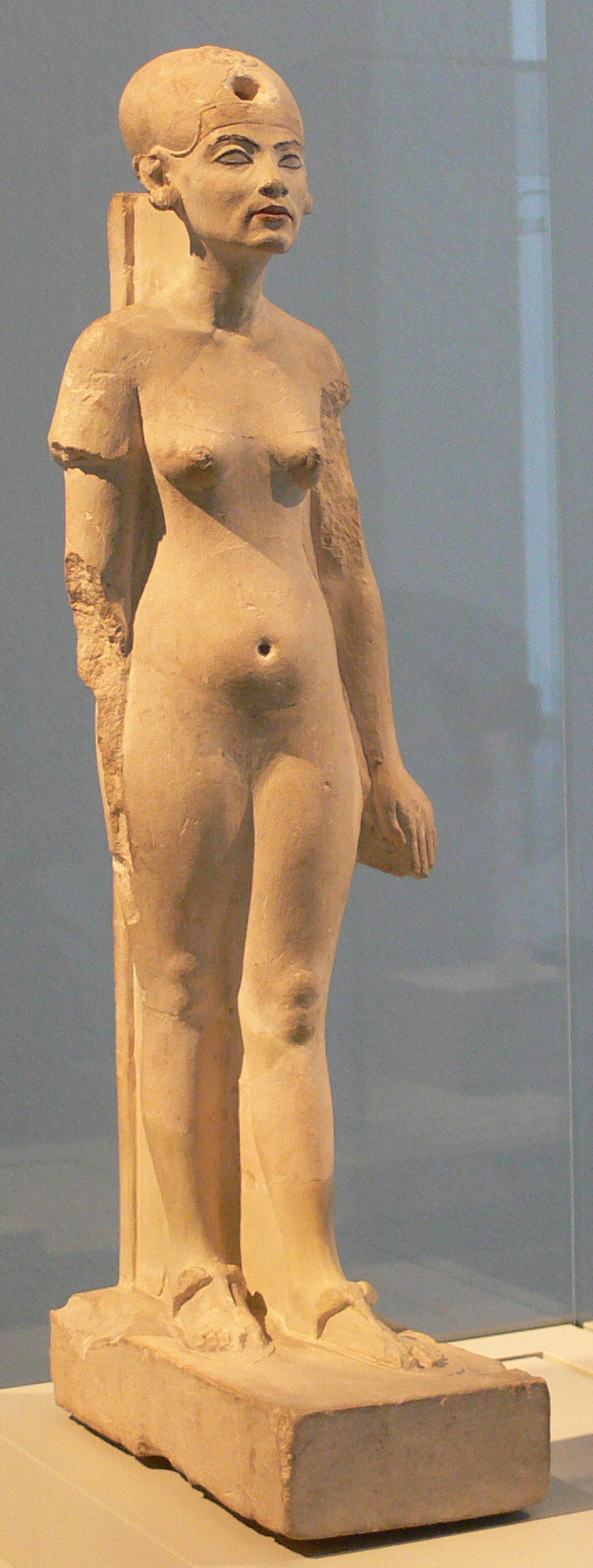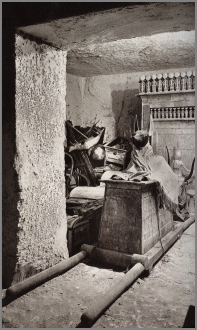|
Ankhesenamun
Ankhesenamun (, "Her Life Is of Amun"; c. 1348 or c. 1342 – after 1322 BC) was an ancient Egyptian queen who lived during the Eighteenth Dynasty of Egypt, 18th Dynasty of Egypt. Born Ankhesenpaaten (, "she lives for the Aten"), she was the third of six known daughters of the Egyptian Pharaoh Akhenaten and his Great Royal Wife Nefertiti. She became the Great Royal Wife of Tutankhamun. The change in her name reflects the changes in ancient Egyptian religion during her lifetime after her father's death. Her youth is well documented in the ancient reliefs and paintings of the reign of her parents. Ankhesenamun was well documented as being the Great Royal Wife of Pharaoh Tutankhamun. Initially, she may have been married to her father and it is possible that, upon the death of Tutankhamun, she was married briefly to Tutankhamun's successor, Ay (pharaoh), Ay, who is believed by some to be her maternal grandfather. DNA test results on mummies discovered in KV21 were released in F ... [...More Info...] [...Related Items...] OR: [Wikipedia] [Google] [Baidu] |
Ankhesenamun Handing Arrow To Seated Tutankhamun
Ankhesenamun (, "Her Life Is of Amun"; c. 1348 or c. 1342 – after 1322 BC) was an ancient Egyptian queen who lived during the 18th Dynasty of Egypt. Born Ankhesenpaaten (, "she lives for the Aten"), she was the third of six known daughters of the Egyptian Pharaoh Akhenaten and his Great Royal Wife Nefertiti. She became the Great Royal Wife of Tutankhamun. The change in her name reflects the changes in ancient Egyptian religion during her lifetime after her father's death. Her youth is well documented in the ancient reliefs and paintings of the reign of her parents. Ankhesenamun was well documented as being the Great Royal Wife of Pharaoh Tutankhamun. Initially, she may have been married to her father and it is possible that, upon the death of Tutankhamun, she was married briefly to Tutankhamun's successor, Ay, who is believed by some to be her maternal grandfather. DNA test results on mummies discovered in KV21 were released in February 2010, which has given rise to spec ... [...More Info...] [...Related Items...] OR: [Wikipedia] [Google] [Baidu] |
Tutankhamun
Tutankhamun or Tutankhamen, (; ), was an Egyptian pharaoh who ruled during the late Eighteenth Dynasty of Egypt, Eighteenth Dynasty of ancient Egypt. Born Tutankhaten, he instituted the restoration of the traditional polytheistic form of ancient Egyptian religion, undoing a previous shift to the religion known as Atenism. Tutankhamun's reign is considered one of the greatest restoration periods in ancient Egyptian history. His endowments and restorations of cults were recorded on what is today known as the Restoration Stela. The cult of the god Amun at Thebes, Egypt, Thebes was restored to prominence, and the royal couple changed their names to "Tutankhamun" and "Ankhesenamun", replacing the -aten suffix. He also moved the royal court from Akhenaten's capital, Amarna, back to Memphis, Egypt, Memphis almost immediately on his accession to the kingship. He reestablished diplomatic relations with the Mitanni and carried out military campaigns in Nubia and the Near East. Tutankh ... [...More Info...] [...Related Items...] OR: [Wikipedia] [Google] [Baidu] |
Nefertiti
Nefertiti () () was a queen of the Eighteenth Dynasty of Egypt, 18th Dynasty of Ancient Egypt, the Great Royal Wife, great royal wife of Pharaoh Akhenaten. Nefertiti and her husband were known for their radical overhaul of state religious policy, in which they promoted the earliest known form of monotheism, Atenism, centered on Aten, the sun disc and its direct connection to the royal household. With her husband, she reigned at what was arguably the wealthiest period of ancient Egyptian history. After her husband's death, some scholars believe that Nefertiti ruled briefly as the female pharaoh known by the throne name, Neferneferuaten and before the ascension of Tutankhamun, although this identification is Neferneferuaten#Nefertiti, a matter of ongoing debate. If Nefertiti did rule as pharaoh, her reign was marked by the fall of Amarna and relocation of the capital back to the traditional city of Thebes, Egypt, Thebes. In the 20th century, Nefertiti was made famous by the disco ... [...More Info...] [...Related Items...] OR: [Wikipedia] [Google] [Baidu] |
Eighteenth Dynasty Of Egypt
The Eighteenth Dynasty of Egypt (notated Dynasty XVIII, alternatively 18th Dynasty or Dynasty 18) is classified as the first dynasty of the New Kingdom of Egypt, the era in which ancient Egypt achieved the peak of its power. The Eighteenth Dynasty spanned the period from 1550/1549 to 1292 BC. This dynasty is also known as the Thutmoside Dynasty for the four pharaohs named Thutmose. Several of Egypt's most famous pharaohs were from the Eighteenth Dynasty, including Tutankhamun. Other famous pharaohs of the dynasty include Hatshepsut (c. 1479 BC–1458 BC), the longest-reigning woman pharaoh of an indigenous dynasty, and Akhenaten (c. 1353–1336 BC), the "heretic pharaoh", with his Great Royal Wife, Nefertiti. The Eighteenth Dynasty is unique among Egyptian dynasties in that it had two Queen regnant, queens regnant, women who ruled as sole pharaoh: Hatshepsut and Neferneferuaten, usually identified as Nefertiti. History Early Dynasty XVIII Dynasty XVIII was founded by Ahmo ... [...More Info...] [...Related Items...] OR: [Wikipedia] [Google] [Baidu] |
317a And 317b
Mummies 317a and 317b are the remains of two infant daughters of Tutankhamun, a pharaoh of the Eighteenth Dynasty of Egypt. Their mother, who has been tentatively identified through DNA testing as the mummy KV21A, is presumed to be Ankhesenamun, his only known wife. 317a was born prematurely at 5–6 months' gestation, and 317b was born at or near full term. They are assumed to have been stillborn or died shortly after birth. They were buried in their father's tomb in the Valley of the Kings, which was discovered by the Egyptologist Howard Carter in 1922. Their bodies were mummified and wrapped in the same style as high-status adults and 317a was fitted with a gilded mummy mask; 317b's mask was too small for her and was found in 1907 among the leftovers from Tutankhamun's mummification and funerary feast cached in KV54. Each girl was buried in miniature two-coffin sets of the same design used by nobility. Both babies were unnamed, as the coffin inscriptions call them only the ... [...More Info...] [...Related Items...] OR: [Wikipedia] [Google] [Baidu] |
Ay (pharaoh)
Ay was the penultimate pharaoh of ancient Egypt's Eighteenth Dynasty of Egypt, 18th Dynasty. He held the throne of Egypt for a brief four-year period in the late 14th century BC. Prior to his rule, he was a close advisor to two, and perhaps three, other pharaohs of the dynasty. It is speculated that he was the power behind the throne during child ruler Tutankhamun's reign, although there is no evidence for this aside from Tutankhamun's youthfulness. His ''Prenomen (Ancient Egypt), prenomen'' ''Kheperkheperure'' means "Everlasting are the Manifestations of Ra", while his ''nomen (Ancient Egypt), nomen'' ''Ay it-netjer'' reads as "Ay, Father of the God". Records and monuments that can be clearly attributed to Ay are rare, both because his reign was short and because his successor, Horemheb, instigated a campaign of ''damnatio memoriae'' against him and the other pharaohs associated with the unpopular Amarna Period. Origins and family Ay is believed to have been from Akhmim. During ... [...More Info...] [...Related Items...] OR: [Wikipedia] [Google] [Baidu] |
Akhenaten
Akhenaten (pronounced ), also spelled Akhenaton or Echnaton ( ''ʾŪḫə-nə-yātəy'', , meaning 'Effective for the Aten'), was an ancient Egyptian pharaoh reigning or 1351–1334 BC, the tenth ruler of the Eighteenth Dynasty of Egypt, Eighteenth Dynasty. Before the fifth year of his reign, he was known as Amenhotep IV (, meaning "Amun is satisfied", Hellenized as ''Amenophis IV''). As a pharaoh, Akhenaten is noted for abandoning traditional ancient Egyptian religion of polytheism and introducing Atenism, or worship centered around Aten. The views of Egyptologists differ as to whether the religious policy was absolutely monotheism, monotheistic, or whether it was monolatristic, religious syncretism, syncretistic, or henotheistic. This culture shift away from traditional religion was reversed after his death. Akhenaten's monuments were dismantled and hidden, his statues were destroyed, and his name Damnatio memoriae, excluded from regnal list, lists of rulers compiled by lat ... [...More Info...] [...Related Items...] OR: [Wikipedia] [Google] [Baidu] |
List Of Ancient Egyptian Royal Consorts
This is a list of known Queen consort, royal consorts of ancient Egypt from c.3100 BC to 30 BC. Reign dates follow those included on the list of Pharaohs page. Some information is debatable and interpretations of available evidence can vary between Egyptologists. Background The Pharaoh's wives played an important role both in public and private life, and would be a source of political and religious power. Pharaohs usually had many different wives, so that a successor could be guaranteed to succeed him. If a queen succeeded in producing an heir that inherited the throne, she would reach a position of great honour as King's Mother and may be able to rule Egypt on behalf of her son as regent if he was underage. While there are many known cases of kings marrying their sisters, there were also wives of non–royal birth, such as Tiye and Nefertiti. Kings such as Amenhotep III and Ramesses II are known to have married some of their daughters, though it is possible these marriages were ... [...More Info...] [...Related Items...] OR: [Wikipedia] [Google] [Baidu] |
KV21
Tomb KV21 is an ancient Egyptian tomb located in the Valley of the Kings in Egypt. It was discovered in 1817 by Giovanni Battista Belzoni, Giovanni Belzoni and later re-excavated by Donald P. Ryan in 1989. It contains the mummy#Egyptian mummies, mummies of two women, thought to be Eighteenth dynasty of Egypt, Eighteenth Dynasty queens. In 2010, a team headed by Zahi Hawass used DNA evidence to tentatively identify one mummy, KV21A, as the biological mother of the 317a and 317b mummies, two fetuses preserved in the tomb of King Tutankhamun. Architecture The tomb consists of a sloping descending passageway, a staircase, and another descending passage. The passage ends in a room with a single central column and a small chamber adjoining it. The walls are well cut and ready to receive plaster if plastering was intended. The tomb is most similar in layout scale to KV32, the tomb of Tiaa, mother of Thutmose IV. Marc Gabolde considers that the more precise cutting and regular layout of th ... [...More Info...] [...Related Items...] OR: [Wikipedia] [Google] [Baidu] |







